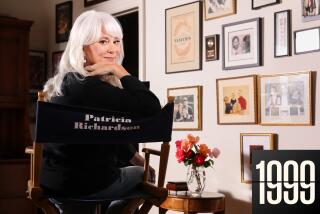Disney Hopes Dinosaur Gains Main St. Toehold
Mr. Lincoln, meet Lucky.
Walt Disney created a sensation at the New York World’s Fair in 1964 when he introduced the world’s first fully animated human figure in “Great Moments With Mr. Lincoln.” It remains one of Disneyland’s most cherished fixtures.
Now, Walt Disney Co. scientists and engineers have fashioned a dinosaur named Lucky, a prototype of the next generation of audio-animatronic figures and a far cry from the relatively clunky rendering of the 16th president.
In fact, 20-foot-long Lucky is fully mobile and can interact with guests -- through the help of a human operator. The creature, which smiles, grunts, belches, bats his eyelashes and signs clover-shaped autographs, had a test run at Disney’s California Adventure last week.
The technology behind Lucky underscores a growing push by Disney, the world’s largest theme park operator, to find new ways to engage customers, by offering more intimate, interactive experiences. Lucky arrives at a time when Burbank-based Disney is struggling through an industrywide slump that has eroded profit in its cornerstone theme park business.
“In our business, you can’t rest on your laurels; you’ve got to constantly invent what the future is,” said Tom Fitzgerald, senior creative executive for Walt Disney Imagineering. “Walt always wanted his characters to live and breathe -- this is a natural evolution of that.”
Disney won’t say where or when it will roll out Lucky and similar characters, because they’re still in the experimental stage. But the company says advanced audio-animatronic technology opens up vast new entertainment possibilities for characters to interact with customers in live shows and during random Main Street encounters.
Someday, Disney says, Mr. Lincoln himself could be rebuilt and given the ability to walk off his stage at Disneyland.
“Something like this has never been done before,” said Burbank theme park consultant Bob Rogers, who has done consulting work for Disney. “It opens up new possibilities for all of us in the theme park industry.”
Lucky uses the latest in computer and battery technology to be both mobile and portable.
There are other advanced audio-animatronic characters, including Pal Mickey, a talking doll introduced at Walt Disney World this year that can be rented for $8 a day and serves as a park guide. And Meeko, the raccoon character from the Disney animated movie “Pocahontas,” made a limited appearance during a live show at Disneyland last year.
As part of its “Living Characters” initiative, Disney Imagineers last year introduced an attraction at California Adventure featuring a virtual “Stitch” from the movie “Lilo & Stitch.” Stitch appears on a video screen and talks to kids on a telephone.
Shrouded in secrecy at Disney’s Imagineering division in Glendale, the Lucky project has been five years in development.
Unlike the earlier animatronic figures that operated by hydraulics, Lucky is operated by electric motors and sensors that are controlled through a central computer, which regulates everything from the booming “thud” that accompanies Lucky’s footsteps to the coy batting of his eyelashes.
Engineers said it was paramount to make the creature safe for park goers. One of the early hurdles was figuring out how to keep the 12-foot-tall, 450-pound robot upright. Designers stabilized Lucky, who is fashioned from foam latex, by fastening him to a flower-filled cart that conceals a human operator.
The operator oversees Lucky’s controls, enabling him to respond in real time to human interactions through a series of preprogrammed actions, including sneezing and signing autographs. Another person, dressed as a magician, guides the dinosaur as he lumbers through crowds.
Lucky is patterned after the Gallimimus dinosaur, but designers took some liberties to soften his image so he wouldn’t scare children. Engineers consulted with animators who worked on Disney’s digitally animated movie “Dinosaur.”
“The biggest challenge was how do you go from a blank chalkboard and a bunch of hardware to a child petting a dinosaur that he believes is real,” said Bruce Vaughn, vice president of research and development. “There was nothing we could look at to compare this to.”
More to Read
The biggest entertainment stories
Get our big stories about Hollywood, film, television, music, arts, culture and more right in your inbox as soon as they publish.
You may occasionally receive promotional content from the Los Angeles Times.







